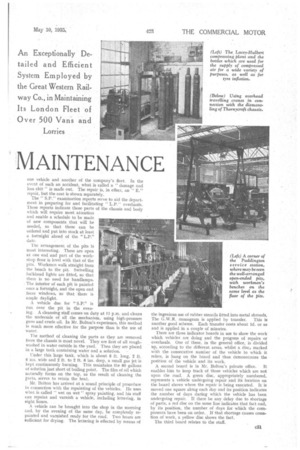MAINTENANCE
Page 89

If you've noticed an error in this article please click here to report it so we can fix it.
one vehicle and another of the company's fleet. In the event of such an accident, what is called a " damage and loss chit" is made out. The repair is, in effect, an repair, but the cost is shown separately.
The " SP." examination reports serve to aid the department in preparing for and facilitating " L.P." overhauls. These reports indicate those parts of the chassis and body which will require most attention and enable a schedule to be made of new components that will be needed, so that these can be ordered and put into stock at least a fortnight ahead of the "L.P." date.
The arrangement of the pits is most interesting. These are open at one end and part of the workshop floor is level with that of the pits. Workmen walk straight from the bench to the pit. Swivelling bulkhead lights are fitted, so that there is no need for handlamps. The interior of each pit is painted once a fortnight, and the open end faces windows, so that there is ample daylight.
A vehicle due for " S.P." is run over the pit in the evening. A cleansing staff comes on duty at 11 p.m. and cleans the underside of all the mechanism, using high-pressure guns and crude oil. In Mr. Bolton's experience, this method is much more effective for the purpose than is the use of water.
The method of cleaning the parts as they arc removed from the chassis is most novel. They are first of all roughwashed in water outside in the yard. Then they are placed in a large tank containing water and a solution.
Under this large tank, which is about 6 ft. long, 2 ft. 6 ins. wide and 2 ft. to 2 ft. 6 ins, deep, a small gas jet.is kept continuously burning. This maintains the 80 gallons of solution just short of boiling point. The film of off which naturally forms on the top, as the result of cleaning the parts, serves to retain the heat.
Mr. Bolton has arrived at a sound principle of procedure in connection with the repainting of the vehicles. He uses what is called " wet on wet" spray painting, and his staff can repaint and varnish a vehicle, including lettering, in eight hours.
A vehicle can be brought into the shop in the morning and, by the evening of the same day, be completely repainted and varnished ready for the road. Two hours are sufficient for drying. The lettering is effected by means of the ingenious use of rubber stencils fitted into metal shrouds. The G.W.R. monogram is applied by transfer. This is another good scheme. Each transfer costs about Id. or so and is applied in a couple of minutes.
There are three indicator boards in use to show the work which, vehicles are doing and the progress of repairs or overhauls. One of these, in the general office, is divided up, according to the different areas, whilst a disc, marked with the consecutive number of the vehicle to which it refers, is hung on the board and thus demonstrates the position of the vehicle and its work.
A second board is in Mr. Bolton's private office. It enables him to keep track of those vehicles which are not upon the road. A green disc, appropriately numbered, represents a vehicle undergoing repair and its location on the board shows where the repair is being executed. It is moved one square along each day and its position indicates the number of days during which the vehicle has been undergoing repair. If there be any delay due to shortage of parts, a red disc on the same line indicates that fact and, by its position, the number of days for which the components have been on order. If that shortage causes cessation of work, a yellow disc shows the fact.
The third board relates to the staff.




































































































































































